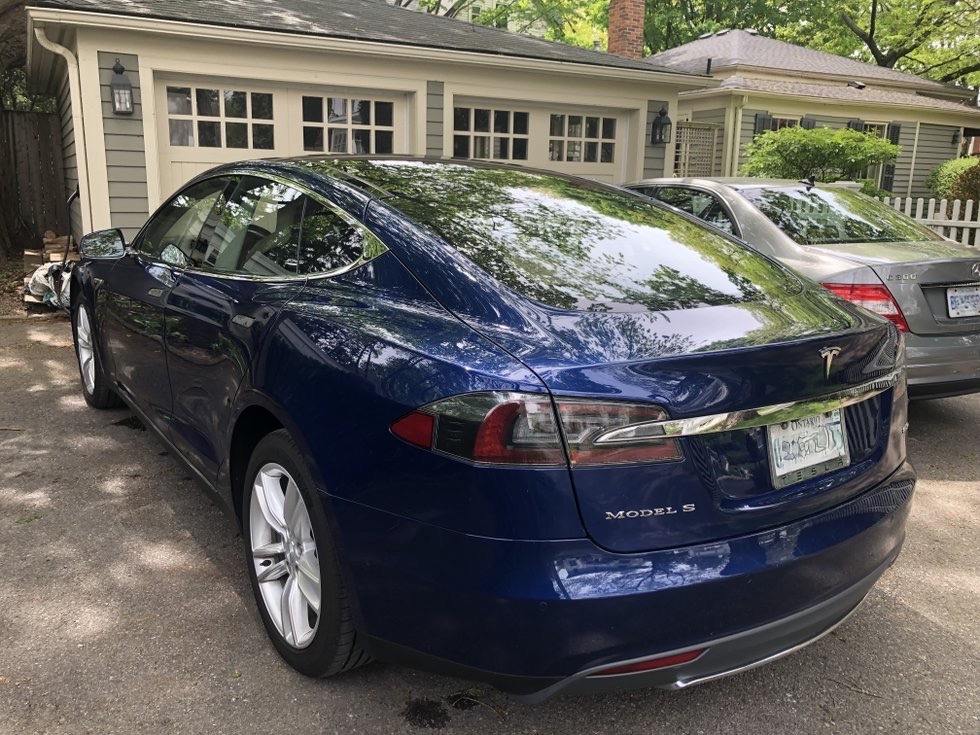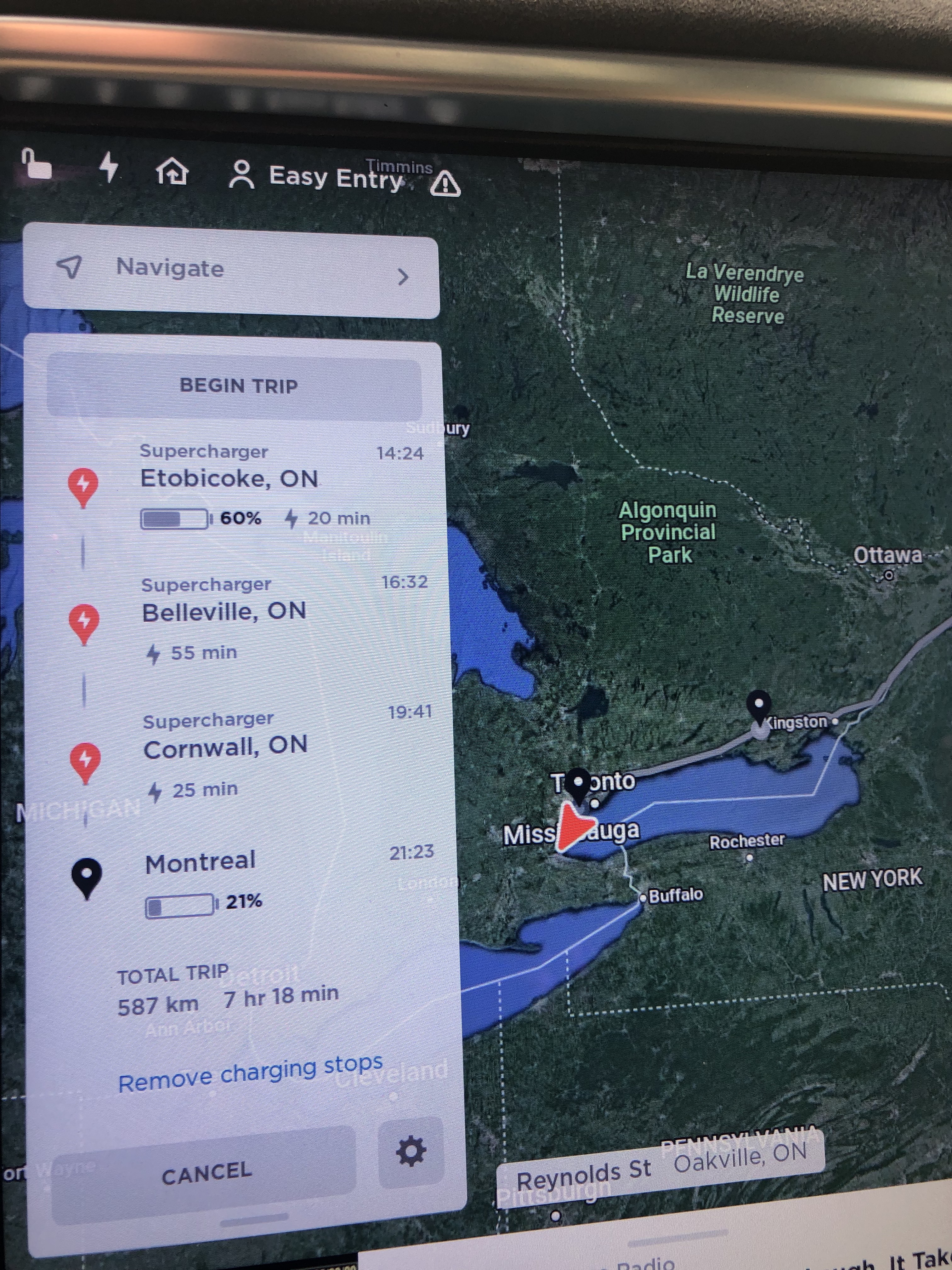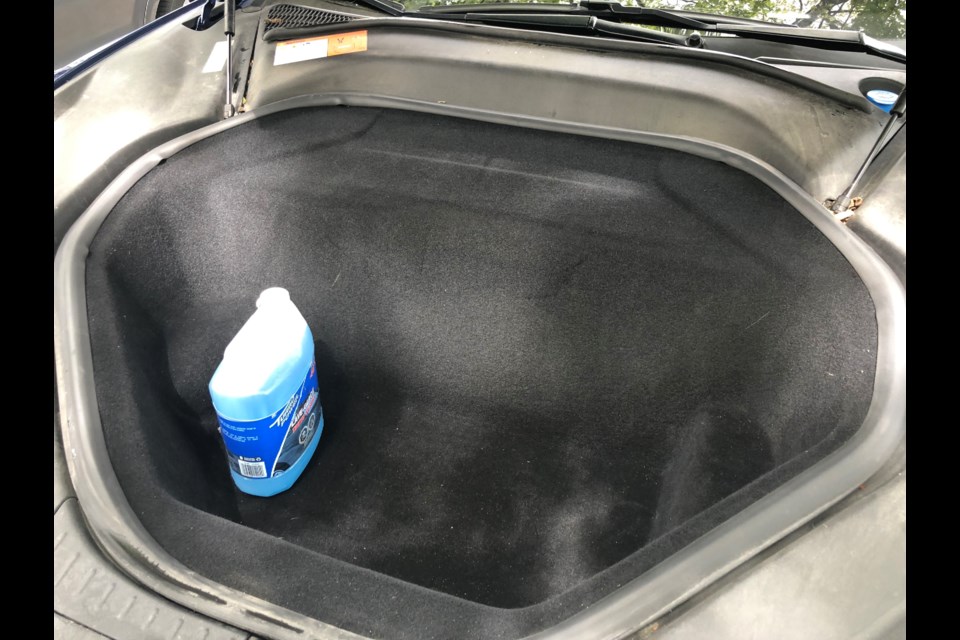
In 2015, wanting to lower our carbon footprint, we bought a Tesla Model S 85D. We wanted our new car to be a real alternative to our primary family car. Not a small car for commutes, errands, and grocery shopping, but a real option for a busy family as the main means of transportation. As more than 50% of car buyers worldwide now say they will buy electric next time around, we thought sharing our experience might be helpful.
At the time there were three of us, along with a dog and a cat. We are active people, driving to work, to the city for entertainment, to horse barns, to ski hills and hockey rinks in the winter, and a cottage in the summer. We even sometimes drive to get away from the snow by taking the car to Florida.
We needed a car with space for luggage, room for the pets, and could take a roof box for skis or the big load at the beginning of the cottage season. Previous vehicles had included Volvo wagons and Jeep Grand Cherokees mostly bought a year or two old.
We knew we didn’t want an SUV this time. Previous experience had taught us that there was no space benefit inside in exchange for the roof box being high up and tough to fill and empty when wearing ski boots (none of us are very tall!).
At the time, only Tesla offered a car with enough range and space for our needs: 415 km on a full battery, a huge trunk, with a big subfloor storage area, and another smaller trunk in front ("frunk"), and, with the sunroof option, provision to put on a roof box.
We were lucky we didn’t need towing, as the Model X which was the SUV alternative at the time, and could be towing equipped, had sexy gull-wing doors which made a roof box impossible to install.
The pictures below illustrate how much space there is, made possible because the electric drive train is so much more compact than a gasoline or diesel one.
So, we narrowed our choice to the Tesla Model S, 85 model (longest range then available, now you can get 500km), and the D for dual motors, one on each axle, that gave us four-wheel drive.
Without the D, you have rear-wheel drive, which is fun, but we were concerned about deep snow in ski country and wanted the security of at least front-wheel drive, which was not an option.
The car cost more than double what we had ever paid for a car before, or ever expected to. And it was a little flashy. Not our style. But we were committed to the idea that the world must transition away from fossil fuels as fast as possible. We wanted to support companies that were helping with that transition, and encourage change by sparking conversations with others, which in 2015 the Tesla’s striking looks certainly did.
Also, we test drove the car. We all like to drive and have had some great handling and performing cars over the years, but the experience of the Tesla was something else again. Exhilarating performance and handling…and guilt-free acceleration. A lot more fun to drive than the largely utilitarian cars we had been in the habit of owning.
So, we set about justifying the purchase. We figured we’d save $3,000 a year on gas after paying for electrical charging at home, and with the 8-year warranty, no tune-ups and no brake jobs, about another $2,500 a year. So, $46,000 over eight years until the warranty ran out. That still left the Tesla 35% more than we had ever spent on a car before, more in fact as many of our previous primary cars had been bought second hand.
In 2015, it was not possible to economically justify the purchase. We were making an investment in the environment. As it happens, it has worked out better. Gas savings are now much higher than they were then. And the car is in a luxury category that is higher than we had previously, so we got that benefit as well.
Today, electric car prices are down, especially with government incentives, and gas prices are up. On top of that, the transition is really picking up speed, and resale prices for gas cars will suffer. There are also fully electric options at more normal car buying levels, with even more range than our car, so the justification can be completely rational. You no longer need to be willing to sacrifice money for your environmental conscience!
So what has the experience been like?
The car is really comfortable and easy to drive on long trips. It is very quiet and you don’t get as tired.
It is very stable: the heavy battery is in the bottom and that makes for great cornering and safe handling.
The weight of the car makes it good in snow: the four wheel drive was probably not necessary.
In 170,000 km we haven’t had a brake job: the regenerative braking slows the car and you only need the brakes for a full stop.
We have needed to replace tires twice (still on the original snows), a bit more often than gas cars because of the weight and torque.
Suspension parts have been replaced under warranty for the same reason, but other than that the car has been very reliable.
What About Range and Charging?
Internal Combustion Engine (ICE) cars heat the cabin with waste heat from the engine. Electric cars don’t generate any waste heat, so they have to heat the cabin with the battery. This, and the effect of cold on battery performance, means winter range is around 30% less depending on how cold it is.
The Tesla has an onboard computer which tells you where to stop to charge when you put your destination in the GPS, and takes into account the cold.
When we first got the car this was very inaccurate and erred on the safe side, but with the over-the-air software updates (the car is connected to the internet) the GPS has improved tremendously and is now really efficient. It tells you when to stop and how long to charge.
Charging does take longer than filling up with gas though.
The twenty-two hour drive from home to Florida is more like 34 with charging. That is in winter when until you get to Kentucky you are using the heater which reduces range.
For us, it means an extra night in a hotel en route.
On the other hand, you don’t stop for gas ever on the rest of your driving: the car saves you time every week all year in exchange for this inconvenience there and back on a very long trip.
Also, Tesla can guide you to overnight charging at picturesque boutique hotels and bed and breakfasts. As a result, we have seen more of the US and enjoyed the travel more than we would have if we had just barrelled down to Florida in an ICE car.
I can’t say enough about the Tesla charging network and the way the car computer makes sure you never worry about range on long trips. This is a huge competitive advantage for Tesla, and other companies are rushing to catch up: it’s not just about building a decent electric car that works and has good range. It’s about solving the whole problem, which Tesla has done. They recognized that you need a real practical alternative that addresses all the demands you put on your car, and they have delivered.

In 7 years, we have maybe had a couple of times when we worried about running out of juice…the same anxiety you get when you realize your gas tank is low and you can’t see a gas station ahead. Of course, if you run out of fuel in an ICE car, someone brings you a jerry can, and you get enough gas to get to the next station.
In an electric car, it’s a tow. Fortunately, that hasn’t happened to us!
The only other thing to consider is unexpected long trips. Because battery life is conserved by partially charging the car, you only fully charge when you are doing a major journey. But if for some reason you must head out on a major trip without warning, you will need to allow time to charge if the car was only ¾ charged overnight.
In the example above, the trip to Montreal will take an extra 20 minutes because at the outset the car is charged only to 275km, instead of the maximum 412. The overall trip is probably an hour longer than in a gas car.
A lot is said about the effect of electric cars on the grid, but most charging happens at night when the grid has excess power. You can program your car to only charge when power prices are at their lowest. And in Ontario, most electricity, especially at night, is hydro or nuclear, so it is generated carbon-free.
Any Reason Not to Buy Electric?
You really need to be able to charge at home, or somewhere very convenient. If you park on the street or have parking in an apartment or condominium garage and can’t plug into a home charger that will fill your battery overnight, you need really to consider what this might mean to you if you drive a lot in a day.
The big advantage of electric is that you start every day with enough charge so you don’t need to stop ever for 95% of your driving. If you can’t do that, you will need to budget charging time for the week.
If you make long trips in the winter, make sure the range is practical for you. One VW model now has a heat pump which improves the winter range.
Conclusion
We have loved our Tesla.
We have driven a top-of-the-line luxury car for seven years with total costs about the same as a more middle-of-the-road full-size well-equipped car. We have another year on the warranty, but we don’t see any reason to fear keeping the car much longer.
The battery still accepts 395 km of charge, which is very little deterioration, and still more than enough to get us to the cottage without a stop.
We paid a premium at the outset, but we think we are now saving about $4,000 a year on gasoline alone. We feel good about not adding carbon to the air when we drive.
We still have an older gas car, which will last ages since we choose the Tesla whenever we can, and whoever is driving the farthest always takes it. When it comes time, we will replace it with another all-electric vehicle without hesitation.
Much of the fear, uncertainty and doubt about electric cars is completely unfounded in our experience. We hope the story of our seven years with an electric car will help you make the right choice for your family...and the planet.
